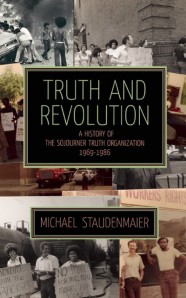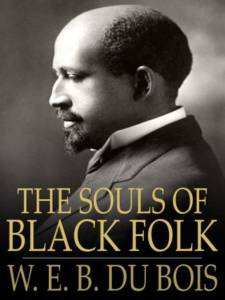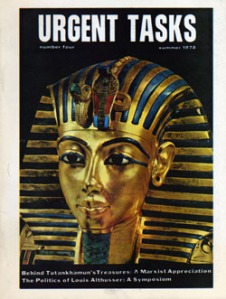Posted by Eve Mitchell
I recently finished reading Michael Staudenmaier’s Truth and Revolution: A History of Sojourner Truth Organization 1969-1986. Sojourner Truth Organization (STO) was a majority white revolutionary group that worked closely with Black Nationalist and Black Power groups to build autonomist workplace, community, identity- and issue-based organizations. They are most known for their theoretical contributions including the white skin privilege analysis and theory of dual consciousness. Perhaps their most well-known writing (which was originally a speech) is “Black Worker, White Worker,” which describes their approach in building militant, fighting groups that organize on the demands of the most oppressed layers of the class. Concretely, in their time and in the spaces they organized, that meant the Black proletarian.
 However, as Truth and Revolution describes, STO was involved in many forms of struggle including the early anti-nuke movement, the women’s liberation movement, some immigrant defense work, among other things. The sheer amount of work they accomplished with very few people and resources in the span of a 17 years is extremely impressive. This post will discuss some other reflections I have on their work. These reflections are relevant to me in this stage of my organizing and experience, having recently moved to New York City and attempted to help build the Florence Johnston Collective (aka Flo Jo), a group that organizes within and across feminized workplaces, alongside working to build Unity and Struggle, a small, national, left communist grouping for the last five years.(1) Obviously both of these tasks have been carried out in an extremely low movement time, in the wake of some interesting struggle globally and some upticks nationally and regionally. My comments may not reflect some of the broader lessons to be learned from STO; I recommend checking out Truth and Revolution itself to extract those.
However, as Truth and Revolution describes, STO was involved in many forms of struggle including the early anti-nuke movement, the women’s liberation movement, some immigrant defense work, among other things. The sheer amount of work they accomplished with very few people and resources in the span of a 17 years is extremely impressive. This post will discuss some other reflections I have on their work. These reflections are relevant to me in this stage of my organizing and experience, having recently moved to New York City and attempted to help build the Florence Johnston Collective (aka Flo Jo), a group that organizes within and across feminized workplaces, alongside working to build Unity and Struggle, a small, national, left communist grouping for the last five years.(1) Obviously both of these tasks have been carried out in an extremely low movement time, in the wake of some interesting struggle globally and some upticks nationally and regionally. My comments may not reflect some of the broader lessons to be learned from STO; I recommend checking out Truth and Revolution itself to extract those.
1. Privilege Theory and STO’s Race Politics.
Elsewhere I have written substantial critiques of how today’s activists and the Left use privilege theory and identity politics. While I think this is qualitatively different from how STO used them, I agree with Staudenmaier when he writes that STO must bear some of the responsibility for how this theory continues to be applied.
STO’s white skin privilege analysis was a breakthrough for the time, breaking down the race fetish. STO showed that where race relations appear individualized (white boss hates black worker), it is in essence is rooted in the organization of the mode of production (speed up under capitalism) (79). This work, as STO was fully aware, could only be informed by the real movement of the class itself. STO was a majority white group with a strong emphasis on autonomy. It makes sense that if you are organizing white people in solidarity with Black people, Latin@s and other people of color, your analysis will be centered around encouraging white people to renounce their privileges and thrown down on the demands of people of color.
However, today, when autonomous organization along race and gender lines are not the norm, and are not the correct historical response to the material relations of capital, the white skin privilege analysis is also incorrect. While it still may be true that white people are given certain “privileges” in the world, this situation is far more complex today and to focus on white privilege puts the Subjectivity and agency on white people, instead of on oppressed people. I think STO’s approach in some small way contributed to this dynamic because they were very unsure about whether they were a multiracial group or an all-white group, and therefore were unsure/unclear about the consequences of either.
Furthermore, in emphasizing white skin privilege as a centerpiece of their theory, STO, (perhaps unwittingly) took an individualistic approach toward the class: individual white workers should renounce their privileges and get down with the Black and Latin@ cause. While I think it was a bit more complex than this because STO argued that the only way for a white worker to truly renounce their privilege is through collective struggle, there is still room for an individualistic approach based on over-emphasizing one side of the totality of capital: the individual white worker. To me, it’s a slippery slope that was never fully worked out in practice or theory.
 Having said all of this, I was extremely impressed with STO’s remarkable division of labor. Two of their theoretical heavy hitters, Noel Ignatien and Don Hammerquist, were able to work extensively on two different (though connected) theoretical projects. Ignatien developed an analysis of white skin privilege rooted in W.E.B. DuBois, and Hammerquist developed a consciousness theory from his reading of Antonio Gramsci. These two projects served as much of STO’s theoretical foundation. Having tenuously built several organizing and theoretical projects over the last several years, it refreshes me to learn that such a level of cooperation is possible among militants. I have hope for the kinds of syntheses we can build together if we are able to have some small level of discipline, trust, and cooperation.
Having said all of this, I was extremely impressed with STO’s remarkable division of labor. Two of their theoretical heavy hitters, Noel Ignatien and Don Hammerquist, were able to work extensively on two different (though connected) theoretical projects. Ignatien developed an analysis of white skin privilege rooted in W.E.B. DuBois, and Hammerquist developed a consciousness theory from his reading of Antonio Gramsci. These two projects served as much of STO’s theoretical foundation. Having tenuously built several organizing and theoretical projects over the last several years, it refreshes me to learn that such a level of cooperation is possible among militants. I have hope for the kinds of syntheses we can build together if we are able to have some small level of discipline, trust, and cooperation.
2. Tendency Building and Practical Unity.
This leads me to my next takeaway. I was interested to learn that STO always put practical unity before theoretical unity. This was their approach both in their earlier days of autonomous group building and their later days of tendency building. In Ignatien’s words, “in all work, it is necessary to demonstrate that the tendency is a living idea, not an abstraction.” These words were moving to read. Recently, I participated in a regroupment/tendency building effort that became paralyzed over abstract theoretical questions. The people I was building with are politically much closer to Unity and Struggle (and me) compared to STO and the groups it worked with. Reflecting on STO’s experience and my own, it has become clear that in any tendency building, regroupment, recruitment, or even maintaining a group, the first foot forward must be practical. There is no point in studying together if you can’t organize through the slow times together or intervene together in an uptick/event.(2) This point has been driven home for me, especially since moving to New York City, where the Left is so theoretically overdeveloped that people will literally theorize their way out of doing anything at all.
I think part of the problem is that in a low movement time, we simply don’t have the answers. The class must clarify these things for us and when the class isn’t moving, there is nothing we can do except prepare ourselves and other advanced layers of the class for that movement. So often the Left will turn inward, organizing and coalition building with itself, starting hundreds of study groups completely detached from the class, and endlessly arguing about high level theory that will be forgotten, rewritten, or disproved (or possibly proven) through practice over the next 10 years. I am now learning that many of the popular theory is cyclical based on whatever is in fashion for whatever reason. I think STO struggled with this too: their final Internal Bulletin in 1983 was the longest ever. There was nothing left to do but nitpick about theory.
3. Gendered Contradictions with the Left.
I’m in the process of co-writing a more lengthy on patriarchy/gendered contradictions within the Left. However, reading Truth and Revolution made me consider a few things. First, many of the women in STO debated with another group, Prairie Fire, on questions of gender and race. STO critiqued Prairie Fire for treating the women of color they organized with as women first and people of color second; whereas STO treated them as people of color (or Puerto Rican nationals) first and women second. In retrospect, it’s clear to see how these approaches are a mere inversion of one another and a dialectical approach would synthesize the two. However, reading about STO made me realize that there are real material divisions based on race and class and despite your political and theoretical approach, at times human relations become flattened in ways you cannot control. It makes me reflect on my own organizing. In what ways has Flo Jo approached people in a flattened sociological or categorical sense? And how can we practice a dialectic between the particular and the universal? Questions to answer another time…
Another key point for me was the way in which STO dealt with gendered contradictions within the group. STO had a rigorous process including a women’s council that was responsible for identifying patriarchal tendencies and male chauvinism, and a judicial-type body. I commend them for attempting to address the issue in ways that many of their contemporaries did not, and I agree with the need to formalize structures within groupings (for a number of reasons).
But STO is also a good example of how gendered contradictions cannot be theorized away. The gains of the 60s and 70s clarified a lot for groups like STO in terms of race. But the feminist movement in many ways tailed the Black Power movement and was unable to clarify a lot of things. If you read Assata Shakur’s autobiography or Elaine Brown’s autobiography, they will tell you that gender is one of the main reasons the Black Panther Party folded. You will see similar things among the Left today (see for example, Courtney Morris’ “Why Misogynists Make Great Informants”). However, without a broad movement that clarifies and works through these contradictions, a group can only do so much. STO did what they could in the realm of theory and formalized structures for dealing with gendered behaviors, but theory and organization will only take you so far. Ultimately, it’s the class that will need to push organizations to make leaps.(3)
4. The Class and Culture.
Since STO was so influenced by CLR James, they placed a strong emphasis on cultural developments as one side of class struggle. Unity and Struggle has historically drawn a lot from James and the Johnson-Forest Tendency so this is an affinity that I naturally share with STO. They would flyer concerts, write articles about movies, books and music, and spent several months studying punk rock. I think over the last few years, and definitely after spending some time in New York City, I’ve begun to overthink my analysis, and it has held me back from writing more about popular culture. I think there is definitely a gendered element to this since I have always struggled with my confidence in writing, especially writing political analysis. But reading Truth and Revolution has inspired me to think more about the role of culture, what today’s culture represents and to write that shit down. So hopefully you’ll see more from me on that soon.

I also really enjoy that STO kept a perspective about cultural work. For example, they concluded that the revolutionary potential of punk rock could only emerge through social movement (196). They didn’t have any illusions about the limitations of culture. I think we could say the same today about hip hop, street art, movies, etc.
Finally, I admire that STO had real and full human lives beyond their political work (198). Staudenmaier comments that this is what made STO’s cultural analysis possible. They were analyzing the things they liked and participated in outside (though of course related to) their political work. This is something I struggle with a lot, especially since moving to NYC, where there is a social pulse that keeps you moving and a sense of urgency that can swallow you up if you’re too slow.
So these are some of the questions Truth and Revolution helped me think through. I definitely have a lot to learn. The great thing about living in NYC is I spend tons of time on the train reading. I’ll definitely be bringing some more reflections on that reading to We’re Hir We’re Queer.
Endnotes.
(1) Maybe I should state that the views expressed here are my own. There is a lot of debate and difference within both Flo Jo and Unity and Struggle and I am definitely not representing the group (nor the group’s unified points) in writing this blog post.
(2) And I would stress that these are two interconnected but separate projects. Some of the people I was working with are resolute to do only one or the other.
(3) This may overemphasize one side of a contradiction that I will fill out with my comrade in our article about patriarchy within the Left coming soon. Here, I am just writing some rough notes.
[…] by Eve Mitchell, originally posted on We’re Hir We’re Queer here. […]